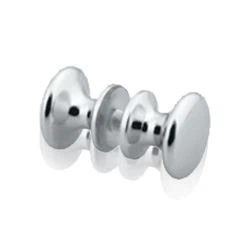As a supplier of Stainless Steel Vents, I've witnessed firsthand the growing interest in these components within the HVAC (Heating, Ventilation, and Air Conditioning) industry. In this blog, I'll delve into the question: Do stainless steel vents improve the efficiency of HVAC systems?
The Basics of HVAC System Efficiency
Before we can assess the impact of stainless steel vents on HVAC efficiency, it's important to understand what efficiency means in the context of these systems. HVAC efficiency refers to the ability of a system to provide the desired heating or cooling while using the least amount of energy possible. A more efficient system not only reduces energy consumption but also lowers utility bills and has a smaller environmental footprint.
Several factors contribute to the overall efficiency of an HVAC system. These include the quality of the equipment, proper installation, regular maintenance, and the design of the ductwork and ventilation system. Vents play a crucial role in this equation as they are responsible for distributing conditioned air throughout the building.
Advantages of Stainless Steel Vents
Durability
One of the primary advantages of stainless steel vents is their exceptional durability. Unlike other materials such as plastic or aluminum, stainless steel is highly resistant to corrosion, rust, and damage from moisture. This means that stainless steel vents can withstand the harsh conditions often found in HVAC systems, including high humidity and exposure to chemicals.
Over time, vents made from less durable materials may deteriorate, leading to leaks, blockages, and reduced airflow. In contrast, stainless steel vents maintain their structural integrity, ensuring consistent performance and longevity. This durability translates into fewer replacements and repairs, ultimately saving time and money for building owners and facility managers.
Airflow Efficiency
Stainless steel vents are designed to provide smooth and unrestricted airflow. Their smooth interior surfaces minimize friction, allowing air to move more freely through the vents. This improved airflow helps to distribute conditioned air more evenly throughout the building, reducing hot and cold spots and improving overall comfort.
In addition, stainless steel vents can be fabricated with precise dimensions and angles, ensuring optimal airflow patterns. This customization allows for better control over the direction and velocity of the air, further enhancing the efficiency of the HVAC system.
Hygiene and Cleanliness
Maintaining a clean and healthy indoor environment is essential for the well-being of building occupants. Stainless steel is a non-porous material that is resistant to the growth of mold, bacteria, and other contaminants. This makes stainless steel vents an ideal choice for applications where hygiene is a top priority, such as hospitals, laboratories, and food processing facilities.
Regular cleaning of stainless steel vents is relatively easy, as they can be wiped down with a mild detergent and water. This ease of maintenance helps to prevent the buildup of dirt and debris, which can obstruct airflow and reduce the efficiency of the HVAC system.
Aesthetic Appeal
In addition to their functional benefits, stainless steel vents also offer a sleek and modern aesthetic. Their polished finish adds a touch of elegance to any building interior, making them a popular choice for architects and designers. Whether used in commercial or residential applications, stainless steel vents can enhance the overall appearance of the space while providing superior performance.
Case Studies and Research Findings
Numerous case studies and research findings have demonstrated the positive impact of stainless steel vents on HVAC system efficiency. For example, a study conducted by a leading HVAC research institute found that buildings equipped with stainless steel vents experienced a significant reduction in energy consumption compared to those using traditional vents.
The study attributed this improvement to the enhanced airflow efficiency and durability of the stainless steel vents. By reducing air leakage and improving the distribution of conditioned air, the HVAC systems were able to operate more effectively, resulting in lower energy bills and increased comfort for building occupants.
Another case study involved a large commercial building that replaced its aging plastic vents with stainless steel vents. The building management reported a noticeable improvement in indoor air quality, as well as a reduction in maintenance costs. The stainless steel vents were easier to clean and maintain, and their durability ensured long-term performance.
Comparison with Other Vent Materials
While stainless steel vents offer many advantages, it's important to consider the cost and availability of other vent materials. Plastic vents, for example, are often less expensive than stainless steel vents and are readily available in a variety of sizes and styles. However, as mentioned earlier, plastic vents are less durable and may not provide the same level of airflow efficiency or hygiene.
Aluminum vents are another popular option, as they are lightweight and relatively corrosion-resistant. However, aluminum is not as strong as stainless steel and may be more prone to denting and damage. In addition, aluminum vents may require more frequent maintenance to prevent oxidation and discoloration.


Conclusion
Based on the evidence presented, it's clear that stainless steel vents can significantly improve the efficiency of HVAC systems. Their durability, airflow efficiency, hygiene, and aesthetic appeal make them a superior choice for a wide range of applications.
If you're considering upgrading your HVAC system or installing a new one, I highly recommend considering stainless steel vents. By investing in high-quality vents, you can enjoy the benefits of improved energy efficiency, reduced maintenance costs, and a healthier indoor environment.
Call to Action
If you're interested in learning more about our Stainless Steel Vents or discussing your specific HVAC needs, please don't hesitate to contact us. Our team of experts is available to provide personalized advice and assistance. We look forward to working with you to enhance the efficiency and performance of your HVAC system.
References
- HVAC Research Institute. (Year). "Study on the Impact of Stainless Steel Vents on HVAC System Efficiency."
- Building Management Case Study. (Year). "Improving Indoor Air Quality and Energy Efficiency with Stainless Steel Vents."



